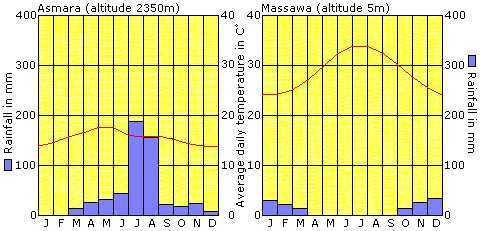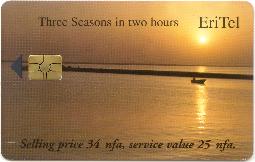Map of Eritrea
Location and geography
Eritrean history
Border conflict with Ethiopia
Political structure
Eritrean anthem
Economy & currency
Climate
People
Languages
Religion
Health care
Transport
Cuisine
News, links, books and more
Asmara (Asmera)
Agordat (Akordat)
Assab (Asseb)
Barentu
Dahlak islands
Dekemhare (Decemhare)
Ghinda (Ginda)
Keren (Cheren)
Massawa (Massauwa)
Mendefera (Adi Ugri)
Nakfa (Nacfa)
Semenawi Bahri (Filfil)
Tessenei
(Teseney)
Climate
Eritrea is located at the highest landmass of the African continent. As a result the highlands of Eritrea have ameliorating climate conditions. Resulting from these climatic conditions at higher altitudes we find vegetative cover and fertile soils which are suitable for agricultural purposes.
Eritrea has a variety of climatic conditions. Asmara at 2,350 meters (7,700 feet) has a pleasant climate all year (average temperature of 16° Celsius (60° Fahrenheit)) and receives 508 mm (20 inches) of rainfall annually. The eastern coastal areas receive the unpredictable, "little rains" (belg) during October to March, while the other areas get "main rains" (kiremti) from June to September.
Eritrea: Three Seasons in two hours.
In the highlands, further inland, with an elevation between 1,800 and 2,100 meters (5,900 and 6,900 feet) the hottest month is usually May (around 30°) and in winter (December to February) temperatures are near freezing point at night.
At sea level along the coast (Massawa, Assab), the period from June to September is very hot (40-50°). In the period December to February (rainy season) the temperature varies from 20 to 35°. Massawa at sea level has an average annual temperature of 30° Celsius (86° Fahrenheit) and an annual precipitation of 205 mm (80 inches).
In the western lowlands (Agordat, Barentu), the temperatures and the rainy seasons are comparable to those on the coast.

Best time to visit
Eritrea is a year-round destination for the highlands while at other places it depends on the place one spends most of one's holidays in or the activities one wishes to undertake. Eritrea is the land where one can experience three seasons in just two hours - from the rugged mountain peaks of Emba Soira to the arid desert heat of the Danakil Depression (100 meters below sea level and which is one of the hottest places on earth) to the cool breezes of the Red Sea.
September to February For the highlands (i.e. Asmara, Keren) November to March For the lowlands / coastal areas December to February For camel safaris in the lowlands What to wear
While clothing will depend on the time of the year, and whether one is in the highlands or on the coast, it is the best to remember that Eritreans like to dress their best at all times, with suits being usual in offices.
For tourists, light cotton clothing, sunglasses and a hat will be required in the lowlands, while in the highlands, light or medium-weight clothing is appropriate. Women are recommended not to wear shorts and strappy T-shirts outside hotel beaches and swimming pools. During the rainy season, a light raincoat and umbrella may prove useful, and a sweater is best for chilly evenings. The sun can be very strong in high altitudes and a high-factor tanning oil and/or protective clothing (long sleeves) is important.
NOTE: The local markets and shops sell a wide range of textile products, which are practical in both hot and cold weather. It may prove useful to take some extra dollars instead of some extra clothing to Eritrea. Buying it in Eritrea will not only stimulate the local economy. The clothes you buy in Eritrea may also be a nice souvenir.

